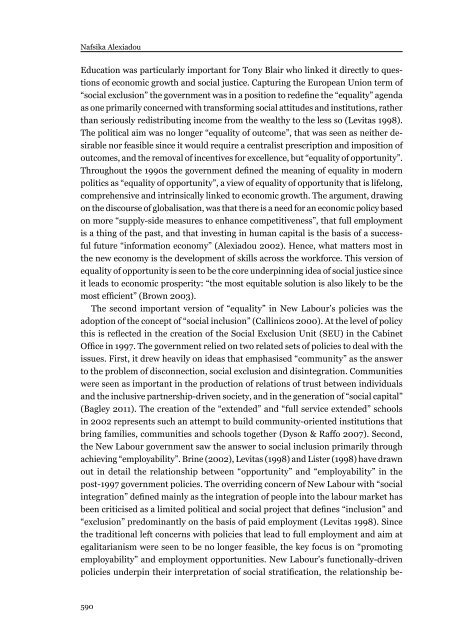Social inclusion and leadership in education: An evolution of roles ...
Social inclusion and leadership in education: An evolution of roles ...
Social inclusion and leadership in education: An evolution of roles ...
- No tags were found...
You also want an ePaper? Increase the reach of your titles
YUMPU automatically turns print PDFs into web optimized ePapers that Google loves.
Nafsika AlexiadouEducation was particularly important for Tony Blair who l<strong>in</strong>ked it directly to questions<strong>of</strong> economic growth <strong>and</strong> social justice. Captur<strong>in</strong>g the European Union term <strong>of</strong>“social exclusion” the government was <strong>in</strong> a position to redef<strong>in</strong>e the “equality” agendaas one primarily concerned with transform<strong>in</strong>g social attitudes <strong>and</strong> <strong>in</strong>stitutions, ratherthan seriously redistribut<strong>in</strong>g <strong>in</strong>come from the wealthy to the less so (Levitas 1998).The political aim was no longer “equality <strong>of</strong> outcome”, that was seen as neither desirablenor feasible s<strong>in</strong>ce it would require a centralist prescription <strong>and</strong> imposition <strong>of</strong>outcomes, <strong>and</strong> the removal <strong>of</strong> <strong>in</strong>centives for excellence, but “equality <strong>of</strong> opportunity”.Throughout the 1990s the government def<strong>in</strong>ed the mean<strong>in</strong>g <strong>of</strong> equality <strong>in</strong> modernpolitics as “equality <strong>of</strong> opportunity”, a view <strong>of</strong> equality <strong>of</strong> opportunity that is lifelong,comprehensive <strong>and</strong> <strong>in</strong>tr<strong>in</strong>sically l<strong>in</strong>ked to economic growth. The argument, draw<strong>in</strong>gon the discourse <strong>of</strong> globalisation, was that there is a need for an economic policy basedon more “supply-side measures to enhance competitiveness”, that full employmentis a th<strong>in</strong>g <strong>of</strong> the past, <strong>and</strong> that <strong>in</strong>vest<strong>in</strong>g <strong>in</strong> human capital is the basis <strong>of</strong> a successfulfuture “<strong>in</strong>formation economy” (Alexiadou 2002). Hence, what matters most <strong>in</strong>the new economy is the development <strong>of</strong> skills across the workforce. This version <strong>of</strong>equality <strong>of</strong> opportunity is seen to be the core underp<strong>in</strong>n<strong>in</strong>g idea <strong>of</strong> social justice s<strong>in</strong>ceit leads to economic prosperity: “the most equitable solution is also likely to be themost efficient” (Brown 2003).The second important version <strong>of</strong> “equality” <strong>in</strong> New Labour’s policies was theadoption <strong>of</strong> the concept <strong>of</strong> “social <strong><strong>in</strong>clusion</strong>” (Call<strong>in</strong>icos 2000). At the level <strong>of</strong> policythis is reflected <strong>in</strong> the creation <strong>of</strong> the <strong>Social</strong> Exclusion Unit (SEU) <strong>in</strong> the Cab<strong>in</strong>etOffice <strong>in</strong> 1997. The government relied on two related sets <strong>of</strong> policies to deal with theissues. First, it drew heavily on ideas that emphasised “community” as the answerto the problem <strong>of</strong> disconnection, social exclusion <strong>and</strong> dis<strong>in</strong>tegration. Communitieswere seen as important <strong>in</strong> the production <strong>of</strong> relations <strong>of</strong> trust between <strong>in</strong>dividuals<strong>and</strong> the <strong>in</strong>clusive partnership-driven society, <strong>and</strong> <strong>in</strong> the generation <strong>of</strong> “social capital”(Bagley 2011). The creation <strong>of</strong> the “extended” <strong>and</strong> “full service extended” schools<strong>in</strong> 2002 represents such an attempt to build community-oriented <strong>in</strong>stitutions thatbr<strong>in</strong>g families, communities <strong>and</strong> schools together (Dyson & Raffo 2007). Second,the New Labour government saw the answer to social <strong><strong>in</strong>clusion</strong> primarily throughachiev<strong>in</strong>g “employability”. Br<strong>in</strong>e (2002), Levitas (1998) <strong>and</strong> Lister (1998) have drawnout <strong>in</strong> detail the relationship between “opportunity” <strong>and</strong> “employability” <strong>in</strong> thepost-1997 government policies. The overrid<strong>in</strong>g concern <strong>of</strong> New Labour with “social<strong>in</strong>tegration” def<strong>in</strong>ed ma<strong>in</strong>ly as the <strong>in</strong>tegration <strong>of</strong> people <strong>in</strong>to the labour market hasbeen criticised as a limited political <strong>and</strong> social project that def<strong>in</strong>es “<strong><strong>in</strong>clusion</strong>” <strong>and</strong>“exclusion” predom<strong>in</strong>antly on the basis <strong>of</strong> paid employment (Levitas 1998). S<strong>in</strong>cethe traditional left concerns with policies that lead to full employment <strong>and</strong> aim ategalitarianism were seen to be no longer feasible, the key focus is on “promot<strong>in</strong>gemployability” <strong>and</strong> employment opportunities. New Labour’s functionally-drivenpolicies underp<strong>in</strong> their <strong>in</strong>terpretation <strong>of</strong> social stratification, the relationship be-590

















